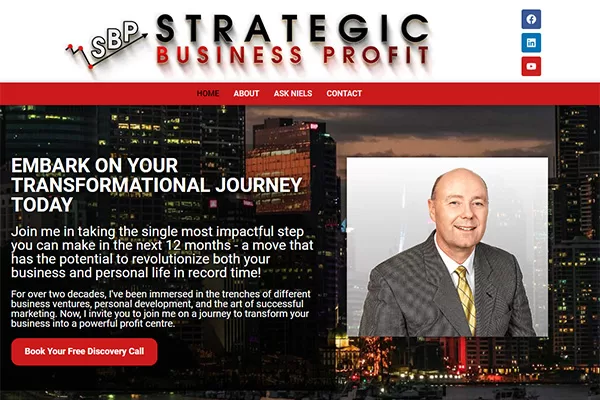We thank Niels and the crew at Strategic Business Profit for the opportunity to create your new website. For Strategic Business Profit we created a Sales Funnel landing page with multiple contact strategies for visitors to get in touch. Strategic Business Profit provides Business Advisory Services, based in Toowoomba, servicing all of Australia.
To view the live website – click here
At WEBDESIGN4BUSINESS we create custom sales funnel websites integrating with all major leads management software tools.
Creating an effective sales funnel website is a crucial aspect of modern marketing strategies. In an era where online presence is paramount for business success, having a website that seamlessly guides potential customers through the buying journey is essential. A sales funnel website isn’t just about attracting visitors; it’s about converting them into paying customers and fostering long-term relationships. In this discourse, we’ll delve into the key components and strategies for crafting a successful sales funnel website.
Understanding the Sales Funnel:
The sales funnel represents the stages a potential customer goes through before making a purchase. These stages typically include awareness, interest, decision, and action. A well-designed sales funnel website addresses each stage effectively, guiding visitors from initial awareness to conversion.
- Awareness: At this stage, visitors become aware of your brand and offerings. This can be through various channels like social media, search engines, or referrals. Your website’s design and content should capture their attention and provide valuable information about how your products or services can solve their problems.
- Interest: Once visitors are aware of your brand, you need to pique their interest and convince them that your offerings are worth exploring further. This stage often involves providing more in-depth content such as blog posts, case studies, or product demos that showcase the benefits of your offerings.
- Decision: In this stage, visitors are evaluating their options and deciding whether to make a purchase. Your website should provide clear calls-to-action (CTAs) and product/service information that helps visitors make informed decisions. Testimonials, reviews, and comparison charts can also be effective in influencing their choices.
- Action: The final stage of the sales funnel involves converting visitors into customers. This could mean making a purchase, signing up for a free trial, or subscribing to a newsletter. Your website should make it easy for visitors to take the desired action by streamlining the checkout process and reducing friction.
Key Components of an Effective Sales Funnel Website:
- Compelling Landing Pages: Landing pages are the entry points to your sales funnel and play a crucial role in capturing visitors’ attention. These pages should have a clear headline, concise copy, compelling visuals, and a prominent CTA that encourages visitors to take the next step.
- Optimized Content: High-quality content is essential for engaging visitors at every stage of the sales funnel. From blog posts and videos to case studies and whitepapers, your content should provide value and address the needs of your target audience. Optimize your content for relevant keywords to attract organic traffic from search engines.
- Lead Magnets: Offer valuable incentives such as ebooks, guides, or free trials in exchange for visitors’ contact information. Lead magnets not only help you capture leads but also allow you to nurture them through email marketing campaigns.
- Email Marketing: Email remains one of the most effective channels for nurturing leads and driving conversions. Segment your email list based on visitors’ interests and behaviors, and send targeted campaigns that provide personalized value and encourage action.
- Social Proof: Incorporate social proof elements such as customer testimonials, reviews, case studies, and user-generated content to build trust and credibility. Seeing positive experiences from other customers can help alleviate doubts and persuade visitors to make a purchase.
- User-Friendly Design: A well-designed website enhances the user experience and encourages visitors to explore further. Ensure your website is visually appealing, easy to navigate, and optimized for both desktop and mobile devices. Minimize loading times and eliminate distractions that could deter visitors from completing the sales process.
- Analytics and Testing: Track key metrics such as conversion rates, bounce rates, and average session duration to measure the effectiveness of your sales funnel. Use A/B testing to experiment with different elements of your website and optimize for better results continuously.
Strategies for Building an Effective Sales Funnel Website:
- Know Your Audience: Understanding your target audience’s needs, preferences, and pain points is fundamental to creating a sales funnel that resonates with them. Conduct market research, gather customer feedback, and create buyer personas to tailor your messaging and content accordingly.
- Map Out the Customer Journey: Visualize the different touchpoints and interactions that potential customers have with your brand across various channels. Map out the ideal path from awareness to conversion, and design your sales funnel to guide visitors seamlessly through each stage.
- Provide Value at Every Stage: Offer valuable content and resources that address visitors’ needs and provide solutions to their problems. Whether it’s educational blog posts, informative videos, or exclusive discounts, aim to provide value at every touchpoint of the sales funnel.
- Focus on Conversion Optimization: Continuously optimize your website and sales funnel to maximize conversions. Test different CTAs, landing page designs, and messaging to identify what resonates best with your audience and drives the highest conversion rates.
- Build Relationships: Building trust and rapport with potential customers is essential for driving long-term loyalty and repeat business. Engage with your audience through social media, email marketing, and personalized interactions to foster meaningful relationships beyond the initial sale.
- Monitor and Iterate: Regularly monitor the performance of your sales funnel and make data-driven decisions to improve results. Identify areas of friction or drop-off points in the funnel, and experiment with different strategies to address them and optimize for better outcomes.
Creating an effective sales funnel website requires a strategic approach that focuses on understanding your audience, providing value at every stage, and optimizing for conversions. By incorporating key components such as compelling landing pages, optimized content, lead magnets, and email marketing, you can attract, engage, and convert visitors into paying customers. Continuously monitor and iterate on your sales funnel to adapt to changing market dynamics and drive sustained business growth. Remember, building a successful sales funnel is an ongoing process that requires dedication, creativity, and a deep understanding of your target audience’s needs and preferences.


